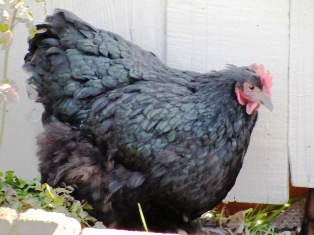If Your Chickens Aren’t Cold Hardy, What Can You Do?
Chickens that can tolerate extreme cold are considered cold-hardy. The Dominique, Hamburg, Langshan, Sussex, and Wyandotte breeds are considered chill tolerant (even cold-hardy) but breeds such as Crevecoeur and Catalana are less tolerant of temperature extremes. So are Bantams and some breeds with large, single combs.
The chickens generate body heat that helps alleviate the cold temperature of a coop. They also wear feathered coats and will huddle together for warmth. A hen house that has insulation and perhaps a south-facing window that captures the warmth of a winter sun can also mitigate extreme cold.
Still, if you live in an area where the temps are below freezing, where it snows, and where the wind contributes to the chill, you might want to hang an ordinary light bulb (40-60 watts) or a 50-watt red bulb if you worry about frost-bitten chickens on those coldest nights.
Put that lamp on a timer. But beware of hanging any electric light that could get knocked down. It could set your coop on fire. And cold-tolerant breeds probably don’t need the extra heat anyway.
Perhaps equally, if not more, important are the chickens’ need for fresh water, ventilation, and a dry environment during winter. You don’t want the chickens roosting in a draft, but you do need ventilation in the coop, for example, via egg-access doors, windows, or ventilation holes with screens. They also need a dry environment.
If the coop isn’t insulated, you might stack bales of straw or hay along the walls and scatter pine shavings if your coop has an earthen floor that becomes cold or frozen.

This chicken house has egg access doors, a human door, a window, and is insulated; the art is optional.
Cold-hardy chickens probably will make it through most frosty nights with few to no problems. Your best tool is your ability to observe your chickens for problems. Oh, and you might want to place a thermometer inside the coop for an accurate measurement about how cold it really gets when the ladies (and rooster, too) are all inside.
Don’t judge your chickens’ endurance for cold by your own.
Missing My Chickens
My next door neighbor welcomed us to the neighborhood when we bought the Henny Penny Farmette. He gave us produce from his garden, honey from his hives, eggs, and even the chickens that laid them. We didn’t even have a chicken house back then.
That didn’t stop us. It was summer, I was married to an architect/builder, and we put “build a chicken house” on our list of things to do.
It took about a week to build out the chicken house. The best time to transport chickens are at night when they are calm. You go into their old roost after dark and carry them to their new dwelling.That way, they awaken at dawn in their new home, and the move is a fait accompli.
After the six laying hens moved in, I named them. The white one seemed especially flighty so she became flighty Tighty Whitey. There were two brown hens, Click and Clack; two Mediterranean hens, Henrietta and Heloise; and Mystery, the large black Cochin, who wouldn’t lay many eggs but loves to sit on them.
Since my neighbor believes that every hen house needs a rooster, he brought over a cute little whipper snapper that I named Houdini. What Houdini lacked in height and weight (he was after all a Bantam), he made up for in attitude.
Carlos outdid himself building that chicken house. He insulated it, tiled the floor, put in nesting boxes all along one wall (with little windows that could be opened so you could reach in to gather eggs), and a red thermal light for heat.
One day, inspectors from the city came out to look for standing water before mosquito season began and spotted the spiffy new chicken house. One fellow joked, “If those chickens don’t like it, call me. I’m looking for a new place.”
I grew attached to the chickens; so much so that when I lost two because of prolapsed cloaca, I mourned them as if family members had passed. Then last year, each time I cleaned the chicken house I suffered an asthma attack. This occurred in spite of wearing a mask the entire time I cleaned it. The chickens needed a clean house, but I could no longer be the cleaning lady.
I could not find takers for that job, so with a heavy heart I decided to give my chickens to a Lebanese lady. She wanted the chickens and had family members who would help her take good care of the brood. All the chickens except Mystery moved to the lady’s chicken house. Mystery moved back into the coop next door.
I miss the contented clucking of the chickens as they scratched their way around my yard. I miss Houdini’s gravely cockle-doodle-doo that awakened me before dawn. And I miss the fresh eggs that I would happily gather each morning from the splendid chicken house that Carlos built.
I’m fortunate that my neighbor kindly supplies me with organic eggs from his chickens. When I really get to missing the chickens, I popped over the fence to visit Mystery. Maybe she misses me, too. When I call her name she still answers.
Lately, I’ve been thinking about building a new chicken house with room for one or two chickens. I’d like to be able to move it around the yard on wheels. It would have to be tall enough to contain a roost and it would have to accommodate a nesting box or two, and include a wired section like a big box that could be detached. The whole thing wouldn’t need much cleaning. So, now I I’m trying to find the right time to broach the subject with my architect in residence.
 Facebook
Facebook Goodreads
Goodreads LinkedIn
LinkedIn Meera Lester
Meera Lester Twitter
Twitter









